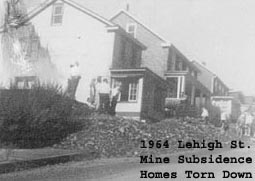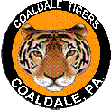April 17, 1993, marked 30 years since Mr. and Mrs. John Pavlick, asleep in their home at 125 East Lehigh Street in Coaldale, were aroused during the early morning hours by a thunderous noise. They thought a landslide was taking place in their basement.
 When Pavlick ripped the floor-boards away to investigate, he discovered a gaping hole. The roof of an abandoned coal mine, perhaps hundreds of feet under the house, had collapsed and the cave-in extended to the surface.
When Pavlick ripped the floor-boards away to investigate, he discovered a gaping hole. The roof of an abandoned coal mine, perhaps hundreds of feet under the house, had collapsed and the cave-in extended to the surface.
The beam from a flashlight showed the hole pitched steeply to an undetermined depth.
The subsidence at the Pavlick home turned out to be just the proverbial tip of the iceberg. In the weeks that followed, the double-block house occupied by the Pavlicks and Mr. and Mrs. Michael Kelley was swallowed by the cave-in.
Awesome to mine inspectors who peered into the pit in the Pavlick basement, the subsidence produced no immediate outward effects on the block of houses along East Lehigh Street, the highest point in Coaldale.
However, on the evening of May 5 there was another thunderous roar. More ground gave way under the Pavlick and Kelley homes and they toppled backwards at a precarious angle as though being slapped by the hand of a giant.
Mrs. Charles Dowling watched from her front porch as the houses began to slip into the ground. At first it appeared they were going to tumble down the sloping backyards and onto Moser Avenue. Mrs. Dowling said it was the most frightening thing she had ever seen.
 First the chimneys disappeared. Then the houses sagged and twisted. The foundations generated a large cloud of dust as they were reduced to rubble. A bathtub rolled out of the Pavlick home, coming to rest in the yard. The first floor came crashing down on the spot where authorities had entered the basement earlier to reassess the conditions. Spectators watching from behind barricades erected a week before ran as the earth shook under their feet.
First the chimneys disappeared. Then the houses sagged and twisted. The foundations generated a large cloud of dust as they were reduced to rubble. A bathtub rolled out of the Pavlick home, coming to rest in the yard. The first floor came crashing down on the spot where authorities had entered the basement earlier to reassess the conditions. Spectators watching from behind barricades erected a week before ran as the earth shook under their feet.
The second cave-in triggered a mass evacuation effort within the block. Immediately, people who had been reluctant to leave their homes had second thoughts. They were quick to realize the magnitude of the danger facing them. Fear that another cave-in could occur any minute spread like wildfire and a state of emergency was declared.
Mrs. Michael Frendak, who spent a sleepless night in her home at 108 East Lehigh Street, said it was the most frightful experience of her life.
Nobody was busier than Mayor Joseph “Chappy” Sharpe. He was constantly at the scene with the experts, offering assistance and advice. In addition, he arranged dozens of emergency meetings and made countless telephone calls in his search for help.
Mayor Sharpe was credited as the man who turned the disaster into an eventual triumph by paving the way for Coaldale to qualify for federal redevelopment aid.
The house where the Pavlicks and Kelleys had lived was all but swallowed completely. When winter arrived, the roof was almost level with the ground.
By that time the block was deserted. Eventually all the houses within the danger zone were razed. The owners were reimbursed at prices based on the estimated value of the houses before the cave-in. Finally, hundreds of tons of slag were dumped into the hole to stabilize the area.
As the restoration project progressed there was serious talk about building a public park at the site after it was deemed safe, but the park never materialized.

 When Pavlick ripped the floor-boards away to investigate, he discovered a gaping hole. The roof of an abandoned coal mine, perhaps hundreds of feet under the house, had collapsed and the cave-in extended to the surface.
When Pavlick ripped the floor-boards away to investigate, he discovered a gaping hole. The roof of an abandoned coal mine, perhaps hundreds of feet under the house, had collapsed and the cave-in extended to the surface. First the chimneys disappeared. Then the houses sagged and twisted. The foundations generated a large cloud of dust as they were reduced to rubble. A bathtub rolled out of the Pavlick home, coming to rest in the yard. The first floor came crashing down on the spot where authorities had entered the basement earlier to reassess the conditions. Spectators watching from behind barricades erected a week before ran as the earth shook under their feet.
First the chimneys disappeared. Then the houses sagged and twisted. The foundations generated a large cloud of dust as they were reduced to rubble. A bathtub rolled out of the Pavlick home, coming to rest in the yard. The first floor came crashing down on the spot where authorities had entered the basement earlier to reassess the conditions. Spectators watching from behind barricades erected a week before ran as the earth shook under their feet.